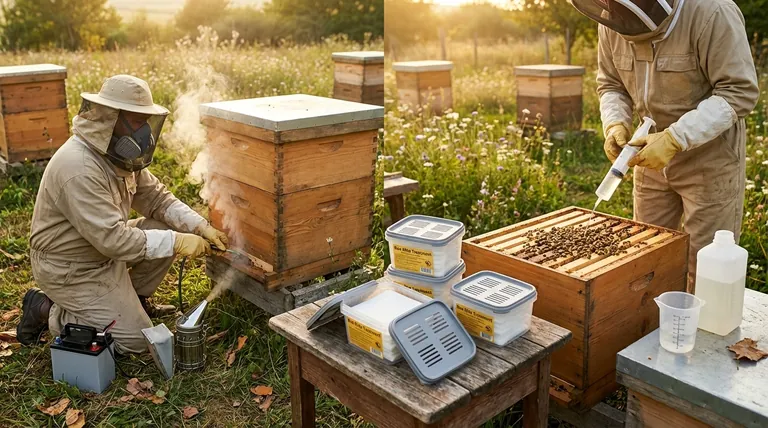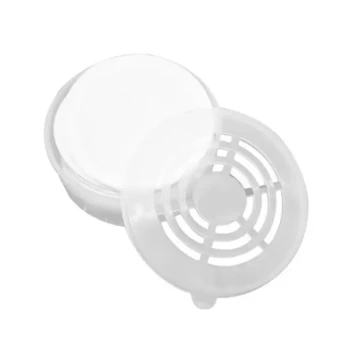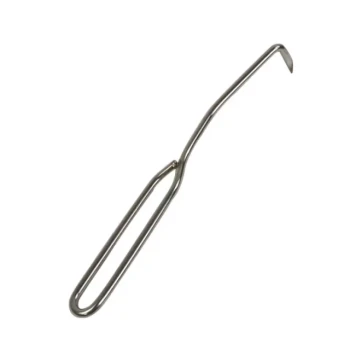In terms of bee safety, the vaporization method is definitively considered less harmful to the colony than the dribble method. The primary reason is that vaporization treats the hive with a fine mist that coats surfaces indirectly, whereas the dribble method involves pouring a liquid solution directly onto the bees. This direct contact can cause stress, chilling, and increased mortality within the cluster.
The central decision between vaporization and dribbling is a trade-off: Vaporization prioritizes the safety of the bees and brood at the cost of increased risk to the beekeeper, while the dribble method is simpler and safer for the operator but harsher on the colony.

The Core Difference: Direct vs. Indirect Application
Understanding how each method delivers the treatment is key to grasping its impact on the hive. The methods are fundamentally different in their mode of action.
How Vaporization Works
Vaporization uses a specialized tool to heat oxalic acid crystals, turning them into a vapor or fine mist. This mist fills the entire hive cavity, settling on all surfaces, including the bees.
This is a form of indirect contact. The bees are not drenched in a liquid, which significantly reduces the risk of chilling them, a major concern during cooler weather.
How Dribbling Works
The dribble method involves mixing oxalic acid with a sugar syrup solution. This liquid is then measured and trickled or "dribbled" directly onto the bees clustered between the frames.
This is direct contact. While effective at killing mites on the bees it touches, it wets the bees, which can be stressful and dangerous for the colony, especially when temperatures are low.
Impact on Colony Health
The method you choose has direct consequences for the well-being of your bees, particularly during vulnerable periods.
Bee and Brood Safety
Vaporization is widely regarded as the gentler option. By avoiding direct liquid application, it minimizes the risk of killing adult bees through chilling or chemical shock.
Because it is less invasive, it is also considered less detrimental to any brood that may be present, though both methods are most effective in broodless periods.
Hive Disruption and Temperature
The dribble method requires you to fully open the hive to access the spaces between the frames. This breaks the colony's propolis seal and causes a significant loss of heat.
Vaporization is far less disruptive. It can often be administered through the hive entrance or a small, drilled hole, keeping the hive sealed. This makes it the superior choice for treatments in late fall or winter when maintaining hive temperature is critical for survival.
Understanding the Trade-offs
Choosing a treatment is not just about bee safety; it involves practical considerations for the beekeeper as well.
Beekeeper Safety
This is the most significant drawback of vaporization. The oxalic acid fumes are highly corrosive and damaging to the human respiratory system. A properly fitted respirator and other personal protective equipment (PPE) are non-negotiable when vaporizing.
The dribble method, while requiring careful handling of the acid when mixing, poses a much lower risk to the beekeeper during application.
Equipment and Complexity
The dribble method is simple and requires minimal equipment: a measuring syringe and a container for mixing.
Vaporization requires a specialized and more expensive tool—the vaporizer itself—as well as a power source to operate it.
Seasonal Constraints
The dribble method should only be used in warmer conditions when opening the hive will not put the colony at risk of chilling.
Vaporization is the preferred method for cold weather treatments precisely because it is quick and does not require opening the hive.
Making the Right Choice for Your Colony
Your decision should be guided by your specific conditions, priorities, and the time of year.
- If your primary focus is maximum bee safety and treating in cold weather: Vaporization is the clear and superior choice, provided you use the required safety equipment.
- If your primary focus is simplicity and you are treating in warmer weather: The dribble method is a viable option that requires less specialized equipment and poses less personal safety risk.
Understanding these fundamental differences empowers you to protect your colony effectively while managing the associated risks for both the bees and yourself.
Summary Table:
| Method | Bee Safety Level | Key Impact on Colony | Best Application Season |
|---|---|---|---|
| Vaporization | High (Gentler) | Indirect mist application; minimal stress & chilling | Late Fall / Winter |
| Dribble | Lower (Harsher) | Direct liquid contact; can cause stress & chilling | Warmer Weather |
Protect your apiary with the right equipment. HONESTBEE supplies commercial apiaries and beekeeping equipment distributors with high-quality, wholesale-focused supplies. Ensure the safety and health of your colonies with professional-grade tools. Contact our experts today to discuss your needs and enhance your beekeeping operations.
Visual Guide

Related Products
- Compact Circular Bee Mite Treatment Dispenser
- Wholesales Dadant Size Wooden Bee Hives for Beekeeping
- Professional Insulated Winter Hive Wrap for Beekeeping
- Long Langstroth Style Horizontal Top Bar Hive for Wholesale
- Inner Beehive Cover for Beekeeping Bee Hive Inner Cover
People Also Ask
- What are the benefits of organic pest control for bees? Protect Your Hives from Harmful Chemicals
- Why is it important to regularly launder clothing and gloves used in beekeeping? Ensure Hive Health & Beekeeper Safety
- What are some alternative products for dealing with small hive beetles? Effective Management Solutions
- What safety precautions should be taken when using oxalic acid for vaporization? Protect Yourself and Your Bees
- What safety precautions should be taken during Oxalic Acid Vaporization? Essential PPE & Procedures



















